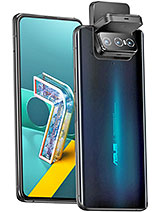Asus Zenfone 7 Pro review

Introduction
Some smartphone form factors only go down in history as one-off experiments, but the Asus Flip Camera isn't that. Improved and enhanced, it returns for a second year in a row on the Zenfone 7 showing that phones can still have moving parts and be cool.
We saw the mechanical slider a couple of times, but neither Xiaomi followed up the Mi Mix 3, nor did Honor with the Magic 2 (and no, we're not counting the Magic 2 3D). Whatever the Oppo Find X motorized contraption can be classified as, the Find X2 didn't want any of it. It's refreshing then that the Flip Camera lives on.
It doesn't just survive, it thrives. It holds three cameras now, a 3x telephoto joining the regular and ultra-wide modules. These two have gotten better too - the main cam now uses the 64MP Quad Bayer sensor in place of the 48MP unit on the Zenfone 6, while the ultra-wide cam gets a big sensor and dual pixel autofocus.
The tele camera was a notable absentee on the older model, but we weren't thrilled with its LCD either. For this generation, Asus talked to Samsung and got a nice 6.67-inch AMOLED, with a middle-ground 90Hz refresh rate too.
A big screen better have a big battery behind it, so the Zenfone 7 comes with the same 5,000mAh capacity power pack of the 6, now with faster charging. And in keeping with the model's position in the market, a flagship chipset is also part of the spec sheet.
 Zenfone 6 (left) next to Zenfone 7 Pro
Zenfone 6 (left) next to Zenfone 7 Pro
This perhaps is a good juncture to point out that there are two Zenfone 7s - a vanilla one and a Pro, with minor differences between them. The Pro gets the Snapdragon 865+ chipset, OIS on both the main cam and the telephoto, and 256GB of storage. The Zenfone 7 proper makes do with the Snapdragon 865 non-plus, non-stabilized optics all around (on otherwise the same cameras), and just 128GB of storage.


Asus Zenfone 7 ZS670KS • Asus Zenfone 7 Pro ZS671KS
What the plain Zenfone 7 has going for it, you guessed correctly, is a lower price tag, and its €700 make is seem like the better deal than the Pro is for €800. While we are reviewing the Pro version, we'll be using 'Zenfone 7' more often than not for the remainder of this review, only pointing out the Pro-vs-vanilla differences where they may be of significance.
Asus Zenfone 7 Pro specs
- Body: 165.1x77.3x9.6mm, 230g; Glass front (Gorilla Glass 6), glass back (Gorilla Glass 3), aluminum frame; Colors: Aurora Black, Pastel White.
- Display: 6.67" Super AMOLED, 1080x2400px resolution, 20:9 aspect ratio, 395ppi; HDR10+, 90Hz refresh rate.
- Chipset: Qualcomm SM8250 Snapdragon 865+ (7 nm+): Octa-core (1x3.1 GHz Kryo 585 & 3x2.42 GHz Kryo 585 & 4x1.8 GHz Kryo 585); Adreno 650.
- Memory: 256GB 8GB RAM (128GB 6/8GB on the non-Pro); UFS 3.1; microSDXC (dedicated slot).
- OS/Software: Android 10, ZenUI 7.
- Camera: Motorized flip-up camera module: Wide (main): 64 MP, f/1.8, 26mm, 1/1.72", 0.8µm, PDAF, OIS (Pro only); Ultra wide angle: 12 MP, f/2.2, 113˚, 17mm, 1/2.55", 1.4µm, dual pixel PDAF; Telephoto: 8 MP, f/2.4, 80mm, PDAF, OIS (Pro only), 3x optical zoom; Dual-LED flash, HDR, auto panorama (motorized rotation).
- Video capture: 8K@30fps, 4K@30/60/120fps, 1080p@30/60/240fps, 720p@480fps; gyro-EIS, HDR.
- Battery: 5000mAh; Fast charging 30W, USB Power Delivery 3.0, Reverse charging.
- Misc: Fingerprint (side-mounted, capacitive), accelerometer, gyro, proximity, compass; NFC.
Some concessions go with the unique form factor - the Zenfone 7 has no IP rating, likely due to the Flip Camera being hard to waterproof. Additionally, with a handset that's already on the thick and heavy side of average, adding wireless charging would have pushed things beyond reason, so it's missing that too. Let's pin this last one on the motorized cam then - there was no room for a 3.5mm jack so it had to go?
Asus Zenfone 7 Pro unboxing
The Zenfone 7 arrives in a larger-than-most cardboard black box with a simulated blue glow along the side edges and a large '7' printed on top. Inside it you get the HyperCharge adapter that supports up to 30W of power output (over USB PowerDelivery with PPS) and a USB-C-to-C cable to go with it.
There's no headset inside, and with the missing 3.5mm jack and no dongle included, you're limited to Bluetooth headphones or getting an aftermarket adapter. Of the assortment we had to test, the Zenfone didn't work with Xiaomi and Sony USB-C-to-3.5mm adapters but did play nicely with Samsung and Pixel ones and the one we had from the ROG Phone 3 (duh!). So passive adapters are a no-go, active ones should normally be fine.

Moving on, the Zenfone 7 is bundled with not one, but two protective cases. Both are made from hard plastic and have mostly the same shape and coverage. One is transparent, the other is pale blue on our Pastel White review unit and black on the Aurora Black version.
This second one is dubbed Asus Active case and features a physical latch to keep the camera from dangling about when, say, the phone is mounted to your bike's handlebar. The Zenfone would recognize the latch is in place and will give you a warning if you try to flip the camera with it engaged.

Reader comments
- Edi
- 27 Jun 2021
- pU8
What will be a better choice, this Asus or samsung S20 FE 5G
- Lakygabi
- 10 Apr 2021
- M8r
Have zenfone 7pro DLNA function? I don't find in specs...
- Anonymous
- 31 Mar 2021
- s3K
Zenfone 7 with Telephoto but not OIS, or 1+ 8T with OIS and no telephoto ?